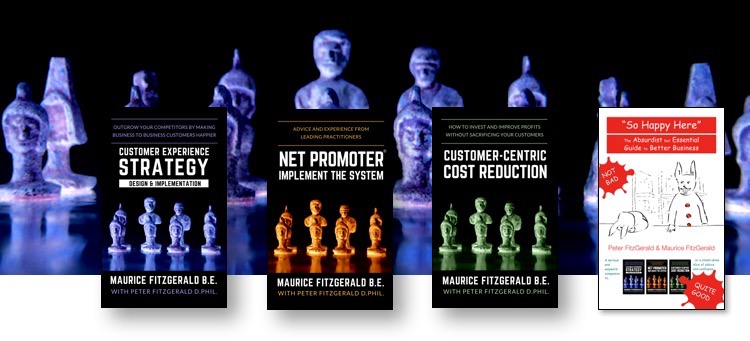#38 – New book, Identifiable Enemies, Ethics, Quality Customer Service
 Welcome to the 38th edition of my customer strategy newsletter. The five topics this week are:
“So Happy Here” – The Absurdist but Essential Guide to Better Business The sharp-eyed among you will have noticed a change to the header of this newsletter and on our website. Yes, my brother and I have collaborated to bring out a book of his business cartoons. You will have seen most of them in our previous books, blog posts, LinkedIn articles and tweets. There are three versions in all. The Kindle version is available from all Amazon stores worldwide. There are both color and black & white versions of the paperback book. By the time you read this, the paperbacks should be available from the Amazon.com, Amazon.co.uk, Amazon.de, Amazon.fr, Amazon.it, Amazon.es and Amazon.co.jp stores. (All versions, and indeed all of our books are great end-of-year presents for your colleagues and teams.) Peter combines his artistic skills with the odd way of thinking he learned while doing his Doctorate in Cognitive Psychology at Oxford. The result is a set of cartoon-style drawings with a weird sense of humor. As I speak to book and blog readers, I learn that different people have different favorites. Mine is probably the one of the company CEO announcing major cost-saving cuts to employees by video link from his private jet. (Don’t do this.) I have added some text to indicate context and learning points for each drawing. As always, your feedback is welcome. Peter can be reached at pfg@customerstrategy.net.
Thoughts about the importance of choosing identifiable enemies Business strategy is all about winning. Winning means winning against someone. Any good business leader needs to be clear about this, and needs to communicate who the enemy is. And that enemy has to make emotional sense to his or her audience. I have been thinking about this during the recent debates about Glyphosate / Roundup in the European Union and here in Switzerland. The main argument being used against Glyphosate is its appearance on the IARC (a World Health Organization subset) list of ‘probably cancer-causing substances’. Being the curious type, I decided to seek out the list to find out what else is on it. The list is here. Please open it, then scroll down past the list of ‘Substances’ (including Glyphosate) to reach the section called ‘Mixtures’. Read carefully. Do you see what I see? Why is Glyphosate the only item that attracts demonstrations in the street? Why do other items on the list, such as ‘Red meat’ and wood used for home heating not attract the same passionate demands for total bans? I think it is because red meat and heating wood are not attractive identifiable enemies. ‘Big Pharma‘ is, and Monsanto is, for some reason. ‘Big Red Meat‘ or ‘Big Heating Wood‘ could not possibly attract the same attention. Based on the logic for a Roundup ban, they should. What do you think? And how do you think this should affect your corporate choice of the evil enemy you need to portray to your employees?
Our latest blog posts Here are the latest posts. The most recent is the first in a set of seven articles I am planning on the main customer experience measurement and improvement systems. Older posts are still available on the blog page.
Notable customer experience items from other sites Entrepreneur Magazine: The 6 Keys to Quality Customer Service Nice article by Nathan Resnick on how to give good service. I have to say that I particularly like his first and fourth points. The first is about delivering the basics. The fourth is about reducing the effort customers have to exert to get what they need. When you open the web page, you will need to click on ‘Start Slideshow’ to see the full article. You can read it here. The Behavioral Scientist’s Ethics Checklist Regular readers and book readers will know that my brother and I are huge fans of behavioral economics; the science that combines economics with behavioral psychology. They way experimenters perform experiments has been the subject of a number of ethics debates. I feel several of the points raised in this in-depth article are relevant to customer research too. The six points covered include data privacy and opt-out policies, among others. Somewhat ironically, the behavioral science website itself does not seem to respect these ethics guidelines. They do track your clicks without asking for your consent, and there is no confidentiality policy that I can find. (We do not track what you do on our site.) Nonetheless, I recommend taking five minutes or so to read the article. You can find it here.
Looking forward Based (so far) on a single request, Peter is going to find a way to produce signed prints of any drawings may like to have in your office or at home. Please share this newsletter with your friends and colleagues and encourage them to sign up for it here. I have put links to past newsletters on the subscription page. Finally, please feel free to change or cancel your subscription using the link below. You can also email me, Maurice FitzGerald, at mfg@customerstrategy.net. To change your subscription, click here.
|






